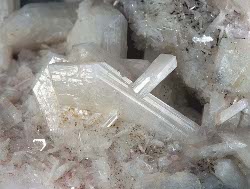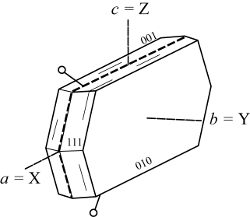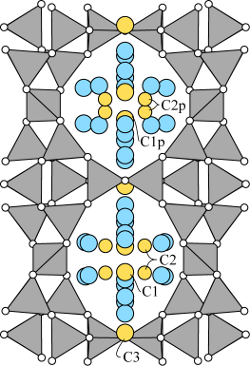| |
Barrerite has been
reported from only a few localities. The two well described
localities are in altered volcanic rock, very near sea level. At the
type locality from Capo Pula, Sardinia, Italy, the host rock is
deeply weathered lava, either andesite or rhyolite that is exposed
nearby in a less altered state (Passaglia and Pongiluppi 1974). The
other occurrence is in the basalt tidal zone of Kuiu Island in
southeastern Alaska (Di Renzo and Gabelica 1997). Experimental
evidence suggests that barrerite cannot be derived from stilbite by
Na-ion exchange, and must therefore, have crystallized from Na-rich
fluids. Barrerite has been reported from other localities in Furtei,
Sardinia, Italy; Nagasaki Pref., Japan; Bay of Fundy, Nova Scotia,
Canada; Cedar Mountain Stone Corp. quarry, Virginia, U.S.A.; Lewis
Cliff, Eastern Antarctica; Bystrinsky and Yelizovsky District,
Kamchatka Krai, Russia; but mineral data or analyses have not been
reported. |
| |
Alberti, A. and
Vezzalini, G. (1978) Crystal structures of heat-collapsed phases of
barrerite. In Natural Zeolites, Occurrence,
Properties Use. Sand, L.B. and Mumpton, F.A. (eds) Pergamon
Press, Oxford, 85-98.
Cametti, G., Armbruster, T. and Nagashima, M. (2016) Thermal
stability of barrerite and Na-exchanged barrerite: An in-situ
single crystal X-ray diffraction study under dry conditions. Microporous
Mesoporous Mater., 236. 71-78.
Di Renzo, F. and Gabelica, Z. 1997. Barrerite and other zeolites
from Kuiu and Kupreanof Islands, Alaska. Can.
Mineral., 35, 691-698.
Galli, E. and Alberti, A. 1975. The crystal structure of
barrerite. Bull. Soc. fr. Mineral. Cristallogr.
98, 331-340.
Ori, S., Mazzucato, E., Vezzalini, G. (2009) Dehydration
dynamics of barrerite: An in situ synchrotron XRPD study. Am.
Mineral., 94 (1) 64-73.
Passaglia, E. and Pongiluppi, D. 1974. Sodian stellerite from
Capo Pula, Sardegna. Lithos, 7, 69-73.
Passaglia, E. and Pongiluppi, D. 1975. Barrerite, a new natural
zeolite. Min. Mag. 40, 208.
Sacerdoti, M., Sani, A., and Vezzalini, G. 1999. Structural
refinements of two barrerites from Alaska. Microporous
Mesoporous Mater. 30, 103-109.
Updated: April 2025.
|
 Barrerite,
Rocky Pass, Kuiu Island, Sitka Borough, Alaska, USA. Image width 3
cm. © Volker Betz.
Barrerite,
Rocky Pass, Kuiu Island, Sitka Borough, Alaska, USA. Image width 3
cm. © Volker Betz.
 The
framework topology of barrerite is the same as stilbite (
The
framework topology of barrerite is the same as stilbite (